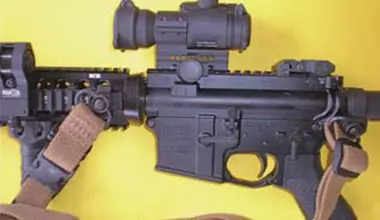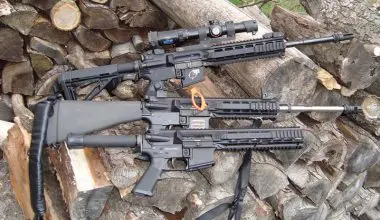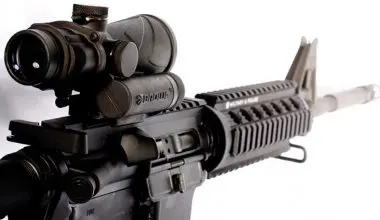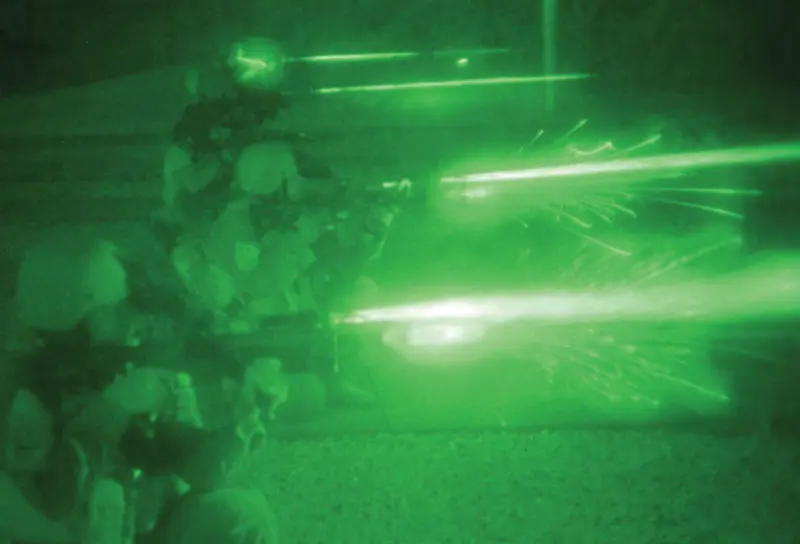
There are a lot of people who should know better who moan about optical sights, anything that uses batteries (God forbid …) and even tactical slings.
For most, the optical sight—primarily the Red Dot Sight (RDS)—is about as advanced as their mission requires. For others, specifically in the military, the RDS is just one part of the suite that gives our guys the ability to win the fight.
While fighting in low light/no light is common for both military and police, many others apparently dismiss that concept as unimportant, and make no attempt to understand what is necessary to win that fight.
Table of Contents
METHODS OF ENGAGEMENT
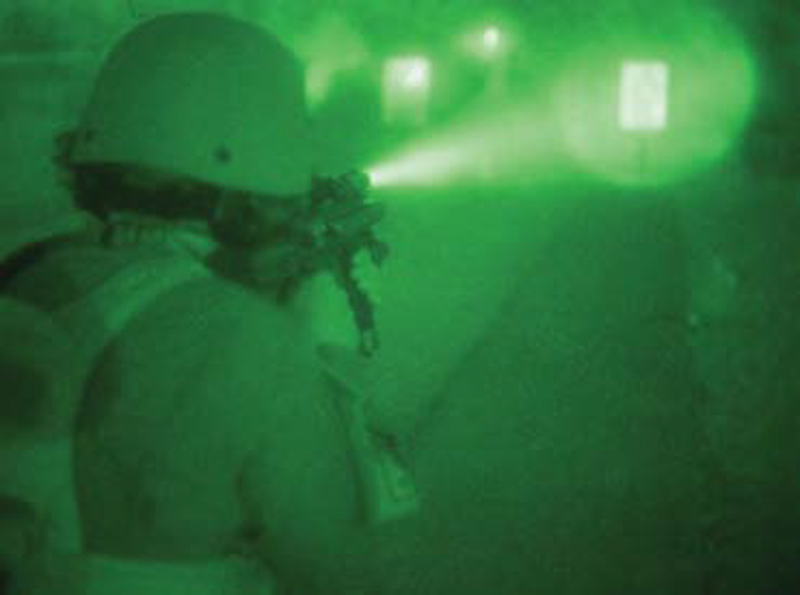
There are several approaches to this issue, but they can be reduced to three:
- Using white light to identify/engage
- Using IR to conduct a stealth approach to contact and then transitioning to white light
- Engaging with IR
Of the three, white light is the most common, especially among cops. While some within the LE community do possess Night Observation Devices (NODs), few may also have carbine-mounted visible or IR lasers. Having only NODs means that engagement requires going to white lights.
Most police agencies are horribly underfunded, have priorities directed toward community policing nonsense, and pay only lip service to anything related to solving issues that involve deadly physical force. Of course when this country experiences a Mumbai-type incident, there will be wailing and gnashing of teeth, but I digress.
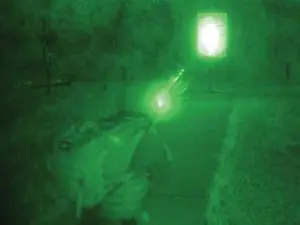
The military is the major consumer of NV—it’s used for infantry combat (to include MOUT) as well as CQB. The TTPs for each are different and beyond the scope of this article.
The U.S. military has a requirement to identify and engage targets in near/ total darkness. This requires two separate items: a night observation device, which is generally mounted on the helmet; and an aiming light mounted on the carbine.
MODERN AIMING LASERS
Broadly speaking, there are three generations of the modern aiming laser.
The first was the AN/PEQ-2 and the product-improved -2A. The target pointer illuminator/aiming light, PEQ-2, was the first modern aiming laser capable of largescale issue to the troops.
The PEQ-2A weighs 7.5 ounces, is 6.4 inches long and provides both the IR aiming light as well as an IR illuminator— think a small infrared flashlight that, when combined with the shooter’s NOD, can aid in target identification.
The -2 and the PI -2A (AN/PEQ-2A (NSN 5855-01-447-8992) are large and difficult to zero. The mount is weak and it eats batteries. They are out of production and are considered legacy items. They are still found in some support units, and the PEQ-2A is often found within some Federal agencies.
Consider that the PEQ-2/2A are more than a decade old, and technology has advanced steadily since then. They are still useful, though not as capable as follow-on units.
To address the issues and encourage a leap forward, the Multi Function Aiming Laser (MFAL) was born. The project resulted in the adoption of two units: the AN/PEQ-15 (the Insight Technologies ATPAIL) and the AN/PEQ-15A (Laser Devices DBAL-A2).
Each of these units improved on the PEQ-2A in several ways:
- Incorporation of a red visible laser slaved to the IR aiming laser. The visible laser allows for the unit to be zeroed during daylight and without the assistance of a second person. In other words, zeroing the visible laser means that the IR laser will also be zeroed. Note that you will need to verify this for obvious reasons.
- It permits the unit to be used as a backup aiming method in low light or in the event of a primary optic failure at close range. This is a much more efficient way of doing business than using a legacy iron sight.
- It incorporates more precise windage and elevation adjustments in both the illuminator and aiming sides of the unit. These adjustment systems were made more robust to allow for a much higher level of zero retention under field conditions.
- It has the ability to use a variety of pattern generators on the illuminator and pointer to assist in confusing situations.
Insight Technologies has also made a progression with their MFAL line. The AN/PEQ-16s combine both the laser and a white light. The AN/PEQ-16A has a 60-lumen incandescent white light, and the PEQ-16B has a 150-lumen LED white light. There is apparently some dissatisfaction with a 60-lumen light, which may be considered weak.
Like the company’s PEQ-15, the body is made of plastic with a screw-mounting system built into the mount. While having the visible and IR laser and a white light integrated into a single unit, having all of the weapons system’s active electronic devices slaved to a single battery source may be problematic in the field.
A fourth generation of MFALs is under development, with most of the effort revolving around electro-optical devices designed to be used with the new powered rails by companies like Rest and Wilcox. The resultant MFALs will be smaller and lighter and powered by the rail’s internal power source.
DBAL-A2
I’d like to focus on the Laser Devices Dual Beam Aiming Laser Advanced 2 (DBAL-A2) and the commercial productimproved version (DBAL-A2 Green).
The issued DBAL-A2 is a small rectangular unit measuring 3.4 inches long, 2.9 inches wide and 1.9 inches high. It weighs 8.2 ounces with the single CR123 battery. That three-volt lithium battery will power the unit for up to five hours of continuous use.
The DBAL-A2 has an IR Aiming Laser, an IR Illuminator and a Red Visible Aiming Laser. Elevation and windage adjustments are on the top/each side of the unit, separating the visible from the IR laser. The adjustments are via a protected knob (more about that later). The controls consist of two rotary knobs. The left knob is the power setting: On Low Power, Momentary Low Power, Off, Momentary High Power, On High Power.
The right knob is the mode selector: Visible Pointer, IR Illuminator, IR Pointer/Illuminator, IR Pointer. The separate switches are difficult to operate (and remember). Gloves, commonly worn, make it even more difficult.
The IR Aiming Laser and the IR Aiming Laser/Pointer are 50mW. The Red Visible Laser is 5mW.
When we first started using the DBALA2s at EAG Tactical courses, we noticed a zero shift at irregular intervals. Based on previous experience with the OEM mounts, we suspected the mount was deficient. We replaced it with a LaRue Tactical 171 mount and, not surprisingly, the zero issue went away.
Laser Devices must have been listening to user feedback, because they dumped the original manufacturer and came out with an in-house mount, the HT. I have used this mount on the PI DBAL-A2 for 8,000 rounds without a problem. That is a clue….
For what it’s worth, I have complete trust in the LaRue system and will switch over to their LT171 mount for this unit as well.
A cautionary note: About 100 of the early DBAL-A2s had the body machined slightly out of tolerance, where the adjustment housing nub on the bottom of the unit was approximately .002 too long. This prevented the LaRue Tactical 171 Mount from fitting. LaRue had a short tutorial on how to make that work, but we did not find it necessary on any of our units. You should not see a problem with current units.
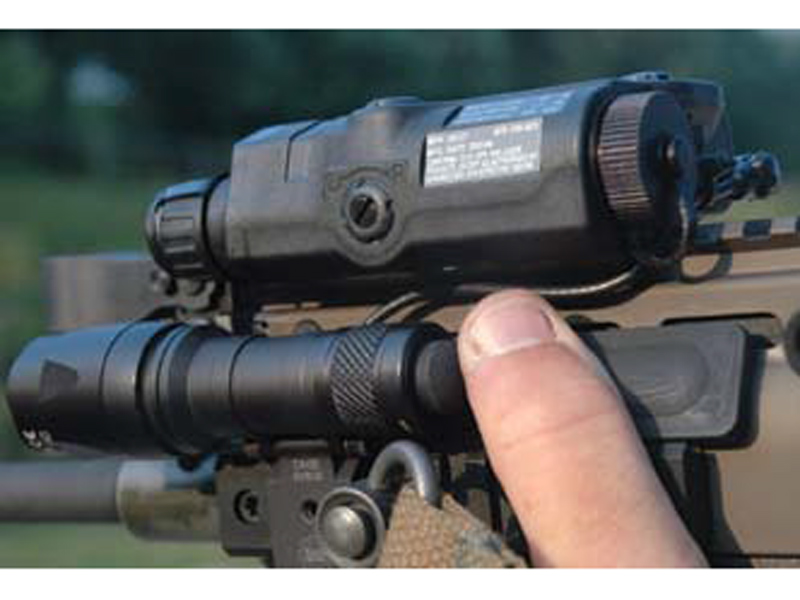
PRODUCT IMPROVED DBAL-A2 GREEN
Laser Devices has a product-improved unit, the DBAL-A2 Green. This unit has several improvements over the currentissue DBAL-A2. I have been running this unit for almost a year now and consequently have enough time on it to comment.
The biggie is that the Red Visible Laser has been replaced with a high-power (50mW) Green Visible Laser. In daylight, the human eye is approximately five times more sensitive to the color green than it is to red. We have used the Green Laser in bright sunlight back to 30 yards and under heavy afternoon cloud cover out to 340 yards.
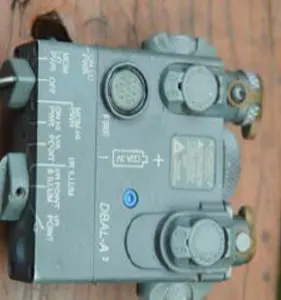
The Green Visible Laser is my go-to back-up sight, rather than using the iron sights.
Another upgrade is that the IR Illuminator is larger in its focusing area and with cleaner edges. The adjustment knob is easier to turn.
The single control knob is a big advantage over the original dual knob controls. This makes operation of the unit much easier, especially at night.
Another great leap forward is that the protected adjustment knobs have gone away and been replaced by large screws. These require a screwdriver/cartridge rim to turn.
This is a major plus, as the protected knobs could/would change zero if rubbed against your gear (make sure you have the Holy Blue Sharpie to mark the knobs).
As mentioned earlier, Laser Devices no longer uses the original mount, having gone to a proprietary mount. This should help with zero/retention issues.
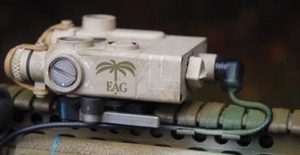
On the downside, they have retained the idiot light on the back of the housing. It is there to remind you if you have the IR on constant. This can bloom if you are using NODs, but a small piece of tape is a quick fix.
TRAINING REQUIRED
As with firearms, mere possession of an MFAL and an NOD will not make the possessor automatically able to engage a threat. In fact, possession without training— proper initial training followed by regular sustainment training—may only make one dangerous to oneself and others.
Solid training in their use is available from LMS Defense, Trident Concepts and others.
Using an NOD and an MFAL is not intuitive. In some cases, it may be counterintuitive compared to what you have done in daylight.
It requires an investment in both money and time, and if you are unable/ unwilling to do both, do everyone a favor and find another job.
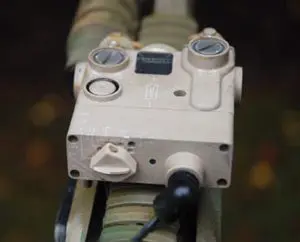
Please note that the sale of MFALs is restricted. Contact a reputable dealer for particulars regarding sale of these items.
The MFAL is an item that is required by relatively few outside of the military. For those who do use it, it is a valuable addition to the mission-essential equipment required to defeat the enemy.
We will likely see great improvement in this field in the near term, as the technology necessary permits more capable units.
A special thanks to John Chapman of LMS Defense. Chappy is a top-shelf trainer and a fount of knowledge on lasers. His ability to magically produce the necessary equipment, smooth troubled waters and provide training is flatout awesome.
Thanks, Brother!
